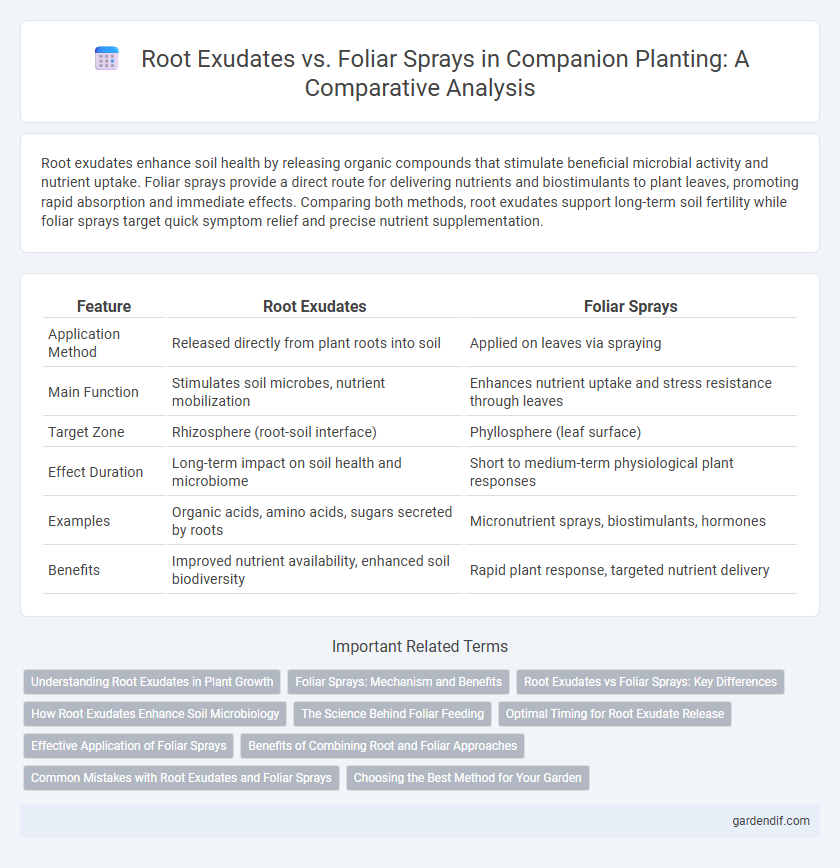
Root exudates vs foliar sprays Illustration
Root exudates enhance soil health by releasing organic compounds that stimulate beneficial microbial activity and nutrient uptake. Foliar sprays provide a direct route for delivering nutrients and biostimulants to plant leaves, promoting rapid absorption and immediate effects. Comparing both methods, root exudates support long-term soil fertility while foliar sprays target quick symptom relief and precise nutrient supplementation.
Table of Comparison
| Feature | Root Exudates | Foliar Sprays |
|---|---|---|
| Application Method | Released directly from plant roots into soil | Applied on leaves via spraying |
| Main Function | Stimulates soil microbes, nutrient mobilization | Enhances nutrient uptake and stress resistance through leaves |
| Target Zone | Rhizosphere (root-soil interface) | Phyllosphere (leaf surface) |
| Effect Duration | Long-term impact on soil health and microbiome | Short to medium-term physiological plant responses |
| Examples | Organic acids, amino acids, sugars secreted by roots | Micronutrient sprays, biostimulants, hormones |
| Benefits | Improved nutrient availability, enhanced soil biodiversity | Rapid plant response, targeted nutrient delivery |
Understanding Root Exudates in Plant Growth
Root exudates are organic compounds secreted by plant roots that play a crucial role in nutrient cycling, microbial interactions, and soil health. Unlike foliar sprays, which deliver nutrients directly to leaves, root exudates influence the rhizosphere by attracting beneficial microbes and enhancing nutrient availability. Understanding root exudates enables optimized companion planting strategies, promoting sustainable plant growth and resilience.
Foliar Sprays: Mechanism and Benefits
Foliar sprays deliver nutrients directly to plant leaves through the cuticle and stomata, enabling rapid absorption and quick nutrient uptake. This mechanism enhances plant growth, boosts disease resistance, and provides targeted nutrient supplementation, especially during critical growth stages. Foliar sprays also improve nutrient use efficiency and reduce soil-related constraints compared to root exudates, making them an effective tool in crop management.
Root Exudates vs Foliar Sprays: Key Differences
Root exudates are naturally secreted by plant roots, releasing organic compounds that enhance soil microbiome health and nutrient availability, while foliar sprays involve applying nutrients or pesticides directly to leaves for rapid absorption. Root exudates primarily influence below-ground interactions, promoting beneficial microbial activity and improving root growth, whereas foliar sprays target above-ground plant tissues for immediate correction of nutrient deficiencies or pest control. The efficiency of nutrient delivery via root exudates depends on soil conditions and microbial populations, contrasting with the quick uptake and localized effect of foliar sprays on plant foliage.
How Root Exudates Enhance Soil Microbiology
Root exudates release organic compounds such as sugars, amino acids, and phenolics directly into the rhizosphere, stimulating beneficial microbial populations like nitrogen-fixing bacteria and mycorrhizal fungi. These compounds improve nutrient cycling, enhance soil structure through microbial biofilm formation, and increase disease suppression by promoting antagonistic microbes against soil pathogens. Foliar sprays bypass the soil microbiome, making root exudates a more effective method for enhancing soil microbial diversity and ecosystem resilience.
The Science Behind Foliar Feeding
Foliar feeding delivers nutrients directly to plant leaves, allowing for rapid absorption and immediate utilization of essential minerals, contrasting with root exudates that release organic compounds to influence soil microbiota for nutrient mobilization. Scientific studies highlight that foliar sprays bypass soil constraints like pH imbalances and nutrient fixation, optimizing nutrient uptake efficiency and promoting quicker plant growth responses. This targeted nutrient delivery improves plant stress resistance and enhances photosynthesis, making foliar feeding a strategic complement to root-based nutrition.
Optimal Timing for Root Exudate Release
Root exudate release peaks during early plant growth stages, coinciding with active root development and microbial colonization. Optimal timing for root exudate application aligns with seedling emergence and initial root expansion to enhance nutrient uptake and soil microbiome interactions. Foliar sprays, in contrast, are most effective during later growth phases when leaf surface area is maximized for nutrient absorption.
Effective Application of Foliar Sprays
Foliar sprays deliver nutrients directly to the plant leaves, enabling faster absorption compared to root exudates that release compounds into the soil for microbial interaction. Effective foliar spray application requires optimal droplet size, targeted timing, and proper environmental conditions to maximize nutrient uptake and minimize runoff. This method enhances nutrient efficiency in companion planting, promoting healthier growth and improved pest resistance.
Benefits of Combining Root and Foliar Approaches
Combining root exudates with foliar sprays enhances nutrient uptake by stimulating beneficial microbial activity in the rhizosphere while directly supplying essential nutrients through leaves. This integrated approach promotes faster plant growth and improved stress resistance, optimizing overall crop health and yield. Synergistic effects between soil and foliar treatments increase the efficiency of nutrient absorption and boost plant metabolic functions.
Common Mistakes with Root Exudates and Foliar Sprays
Common mistakes with root exudates involve overestimating their immediate impact on soil microbiome, leading to improper application timing and nutrient imbalances. Foliar sprays are often misapplied with incorrect concentrations or during suboptimal environmental conditions, reducing nutrient uptake and causing leaf damage. Understanding the specific roles and limitations of root exudates versus foliar sprays is crucial for effective plant nutrient management.
Choosing the Best Method for Your Garden
Root exudates deliver nutrients and beneficial microorganisms directly to the soil, enhancing plant root health and soil structure, making this method ideal for long-term garden vitality. Foliar sprays provide rapid nutrient uptake through leaves, effectively addressing immediate nutrient deficiencies and pest issues. Selecting between root exudates and foliar sprays depends on your garden's specific needs, soil condition, and desired speed of nutrient absorption.
Root exudates vs foliar sprays Infographic

 gardendif.com
gardendif.com